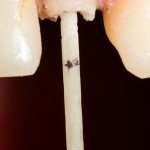
Yesterday (Dental Elf 14th Jan 2012) we looked at a review that compared cast and fibre posts in-vitro. Here we are looking at a trail that compares the use of more flexible, dentine-like (low Young modulus) glass fibre–reinforced epoxy resin posts (GFREPs) with rather rigid, stiff (higher Young modulus) titanium posts (TPs) in order to improve the survival rate of severely damaged endodontically treated teeth.
Adults over 18 years of age with a symptom-free tooth with a root canal filling without a radiologically visible periapical lesion, No or treated periodontitis with a maximum probing depth of 4mm and no bleeding on probing who required post-endodontic treatment were included. Patients were randomised to receive either a tapered TP or tapered GFREP. The main outcome was loss of restoration for any reason. Secondary endpoints were tooth loss, post debonding, post fracture, vertical or horizontal root fracture, endodontic or peri-radicular conditions requiring endodontic retreatment, secondary caries and failure of core build-up, and loss of restoration because of technical failures. The patients were recalled at 3, 6, and 12 months and then annually up to 84 months after post placement for clinical examination.
- 45 patients received GFREP and 46 TPs. A total of 18 patients did not complete the 84-month follow-up period (20.7 %).
- After 84 months of observation (mean = 71.2 months), No statistical difference was found between the survival rates (GFREPs = 90.2%, TPs = 93.5%, P = .642).
- 7 Restorations failed; 4 GFREPs (3 root fractures, 1 core fracture) and 3 TPs (endodontic failure).
- The probability of no failure was comparable for both post materials (risk ratio; 95% confidence interval, 0.965–0.851/1.095)
The authors concluded
When using self-adhesive luted prefabricated posts in severely destroyed abutment teeth with 2 or less remaining cavity walls and a 2-mm ferrule, post-endodontic restorations achieve a high long-term survival rate irrespective of the post material and its rigidity.
Links
Sterzenbach G, Franke A, Naumann M. Rigid versus flexible dentine-like endodontic posts–clinical testing of a biomechanical concept: seven-year results of a randomized controlled clinical pilot trial on endodontically treated abutment teeth with severe hard tissue loss. J Endod. 2012 Dec;38(12):1557-63. doi: 10.1016/j.joen.2012.08.015. PubMed PMID: 23146637.
